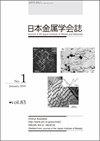Effects of Two-Phase Microstructure Morphology on Mechanical Properties in Co-Base Heat Resistant Alloys Strengthened by E2 1 -(Co, Ni) 3 AlC Phase
IF 0.4
4区 材料科学
Q4 METALLURGY & METALLURGICAL ENGINEERING
引用次数: 0
Abstract
Two-phase microstructure consisting of the E21 type (Co, Ni)3 AlC, κ phase, and (Co, Ni) primary solid solution, α phase, forms having three different characteristic morphologies in the same alloy according to their thermal history. Two of them are observed in the as-cast microstructure; the primary α phase dendrite with fi ne cuboidal κ precipitates, and the eutectic lamellar consisting of α and κ phases. During heat treatments of the alloys at high temperatures, the nodular type discontinuous precipitation (DCP) lamellar, consisting of α and κ phases, forms locally in the primary α dendrite regions as the third morphology. The interlamellar spacing and nodule size of the DCP lamellar becomes larger with increasing heat treatment temperature. Micro-Vickers hardness numbers of the α primary dendrites having κ precipitates and the eutectic lamellar are comparable, and higher than those of the DCP lamellar. The alloy annealed at 1173 K for 96 h exhibits high yield strength, the 0.2% proof stress, exceeding about 800 MPa in compression, and the excellent ductility of 13.6% plastic strain at room temperature in tension. On the other hand, the DCP lamellar formation lowers the strength of the alloys, however high strength about 750 MPa can be maintained in the alloy heat treated at the highest temperature of 1373 K as the lowest yield stress of all. Elevated temperature strength measured at 1123 K for the alloy heat treated at 1173 K is 486 MPa of yield stress in compression. The DCP lamellar formation can be suppressed by the two-step heat treatments and by the unidirectional solidifi cation. The former has more homogeneous distribution of fi ne DCP lamellar than single-step heat treated alloys. The latter is very effective to improve the homogeneity and thermal stability of α and κ twophase aligned microstructure and to maintain high temperature strength of 452 MPa at 1123 K. [doi:10.2320/jinstmet.JBW201611]E2 1 -(Co, Ni) 3alc相强化Co基耐热合金力学性能的影响
两相组织由E21型(Co, Ni) 3alc κ相和(Co, Ni)初生固溶体α相组成,在同一合金中具有三种不同的特征形貌。在铸态组织中观察到其中的两种;初生α相枝晶为细小的立方体κ相,共晶片层由α相和κ相组成。高温热处理过程中,在初生α枝晶区局部形成由α相和κ相组成的球状不连续析出(DCP)片层。随着热处理温度的升高,DCP片层间间距和晶粒尺寸增大。具有κ相的α初生枝晶和共晶片层的显微维氏硬度值相当,且高于DCP片层。该合金在1173 K下退火96 h,表现出较高的屈服强度,抗应力为0.2%,压缩时超过约800 MPa,室温拉伸时塑性应变为13.6%的优异延展性。另一方面,DCP片层的形成降低了合金的强度,但在1373 K的最高温度下,合金的屈服应力最低,可以保持750 MPa左右的高强度。经1173 K热处理的合金在1123 K时的高温强度为486 MPa。两步热处理和单向凝固可以抑制DCP片层的形成。前者比单步热处理合金具有更均匀的DCP片层分布。后者对于改善α和κ两相取向组织的均匀性和热稳定性非常有效,并在1123 k下保持452 MPa的高温强度[doi:10.2320/jinstmet.JBW201611]
本文章由计算机程序翻译,如有差异,请以英文原文为准。
求助全文
约1分钟内获得全文
求助全文
来源期刊

Journal of The Japan Institute of Metals
工程技术-冶金工程
CiteScore
0.70
自引率
0.00%
发文量
27
审稿时长
6-12 weeks
期刊介绍:
Information not localized
 求助内容:
求助内容: 应助结果提醒方式:
应助结果提醒方式:


